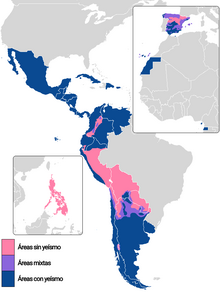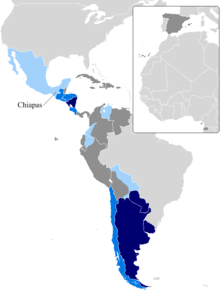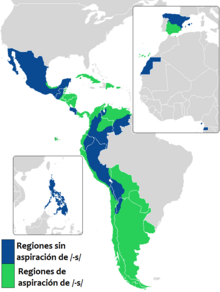In phonetics, rhotic consonants, or "R-like" sounds, are liquid consonants that are traditionally represented orthographically by symbols derived from the Greek letter rho, including ⟨R⟩, ⟨r⟩ in the Latin script and ⟨Р⟩, ⟨p⟩ in the Cyrillic script. They are transcribed in the International Phonetic Alphabet by upper- or lower-case variants of Roman ⟨R⟩, ⟨r⟩: ⟨r⟩, ⟨ɾ⟩, ⟨ɹ⟩, ⟨ɻ⟩, ⟨ʀ⟩, ⟨ʁ⟩, ⟨ɽ⟩, and ⟨ɺ⟩. Transcriptions for vocalic or semivocalic realisations of underlying rhotics include the ⟨ə̯⟩ and ⟨ɐ̯⟩.

Guarani, specifically the primary variety known as Paraguayan Guarani, is a South American language that belongs to the Tupi–Guarani branch of the Tupian language family. It is one of the official languages of Paraguay, where it is spoken by the majority of the population, and where half of the rural population are monolingual speakers of the language.
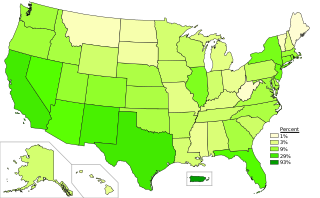
Spanish is the second most spoken language in the United States. Over 42 million people aged five or older speak Spanish at home. Spanish is also the most learned language other than English, with about 8 million students. Estimates count up to 57 million native speakers, heritage language speakers, and second-language speakers. There is an Academy of the Spanish Language located in the United States as well.

The different varieties of the Spanish language spoken in the Americas are distinct from each other as well as from those varieties spoken in the Iberian peninsula, collectively known as Peninsular Spanish and Spanish spoken elsewhere, such as in Africa and Asia. There is great diversity among the various Latin American vernaculars, and there are no traits shared by all of them which are not also in existence in one or more of the variants of Spanish used in Spain. A Latin American "standard" does, however, vary from the Castilian "standard" register used in television and notably the dubbing industry. Of the more than 498 million people who speak Spanish as their native language, more than 455 million are in Latin America, the United States and Canada in 2022. The total amount of native and non-native speakers of Spanish as of October 2022 exceeds 595 million.

Some of the regional varieties of the Spanish language are quite divergent from one another, especially in pronunciation and vocabulary, and less so in grammar.

In Spanish grammar, voseo is the use of vos as a second-person singular pronoun, along with its associated verbal forms, in certain regions where the language is spoken. In those regions it replaces tuteo, i.e. the use of the pronoun tú and its verbal forms. Voseo can also be found in the context of using verb conjugations for vos with tú as the subject pronoun.

Rioplatense Spanish, also known as Rioplatense Castilian, or River Plate Spanish, is a variety of Spanish originating in and around the Río de la Plata Basin, and now spoken throughout most of Argentina and Uruguay. It is the most prominent dialect to employ voseo in both speech and writing. Many features of Rioplatense are also shared with the varieties spoken in south and eastern Bolivia, and Paraguay. This dialect is often spoken with an intonation resembling that of the Neapolitan language of Southern Italy, but there are exceptions.

Jopara or Yopará is a colloquial form of Guarani spoken in Paraguay which uses a number of Spanish loan words. Its name is from the Guarani word for "mixture".

Mexican Spanish is the variety of dialects and sociolects of the Spanish language spoken in the United Mexican States. Mexico has the largest number of Spanish speakers, more than double any other country in the world. Spanish is spoken by over 99% of the population, being the mother tongue of 93.8%, and the second language of 5.4%.

Yeísmo is a distinctive feature of certain dialects of the Spanish language, characterized by the loss of the traditional palatal lateral approximant phoneme and its merger into the phoneme. It is an example of delateralization.

Caribbean Spanish is the general name of the Spanish dialects spoken in the Caribbean region. The Spanish language was introduced to the Caribbean in 1492 with the voyages of Christopher Columbus. It resembles the Spanish spoken in the Canary Islands, and, more distantly, the Spanish of western Andalusia. With more than 25 million speakers, Spanish is the most widely spoken language in the Caribbean Islands.
The Guarani alphabet (achegety) is used to write the Guarani language, spoken mostly in Paraguay and nearby countries. It consists of 33 letters.

Central American Spanish is the general name of the Spanish language dialects spoken in Central America. More precisely, the term refers to the Spanish language as spoken in Costa Rica, El Salvador, Guatemala, Honduras, and Nicaragua. Panamanian Spanish is considered a variety of Caribbean Spanish, it is transitional between Central American and Caribbean dialects.

Chilean Spanish is any of several varieties of the Spanish language spoken in most of Chile. Chilean Spanish dialects have distinctive pronunciation, grammar, vocabulary, and slang usages that differ from those of Standard Spanish. Formal Spanish in Chile has recently incorporated an increasing number of colloquial elements.

Dominican Spanish is Spanish as spoken in the Dominican Republic; and also among the Dominican diaspora, most of whom live in the United States, chiefly in New York City, New Jersey, Connecticut, Rhode Island, Massachusetts, Pennsylvania, and Florida.

Spanish is the language that is predominantly understood and spoken as a first or second language by nearly all of the population of Argentina. According to the latest estimations, the population is currently greater than 45 million.

Colombian Spanish is a grouping of the varieties of Spanish spoken in Colombia. The term is of more geographical than linguistic relevance, since the dialects spoken in the various regions of Colombia are quite diverse. The speech of the northern coastal area tends to exhibit phonological innovations typical of Caribbean Spanish, while highland varieties have been historically more conservative. The Caro and Cuervo Institute in Bogotá is the main institution in Colombia to promote the scholarly study of the language and literature of both Colombia and the rest of Spanish America. The educated speech of Bogotá, a generally conservative variety of Spanish, has high popular prestige among Spanish-speakers throughout the Americas.

Costa Rican Spanish is the form of the Spanish language spoken in Costa Rica. It is one of the dialects of Central American Spanish. Nevertheless, because the country was more remote than its neighbors, the development of this variety of Spanish followed a distinct path.

Nicaraguan Spanish is geographically defined as the form of Spanish spoken in Nicaragua. Affectionately, Nicaraguan Spanish is often called Nicañol.
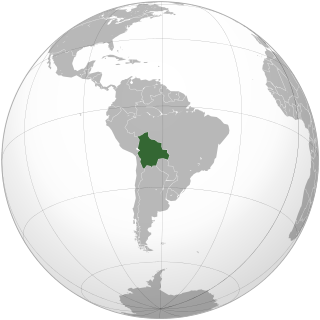
Bolivian Spanish is the variety of Spanish spoken by the majority of the population in Bolivia, either as a mother tongue or as a second language. Within the Spanish of Bolivia there are different regional varieties. In the border areas, Bolivia shares dialectal features with the neighboring countries.

